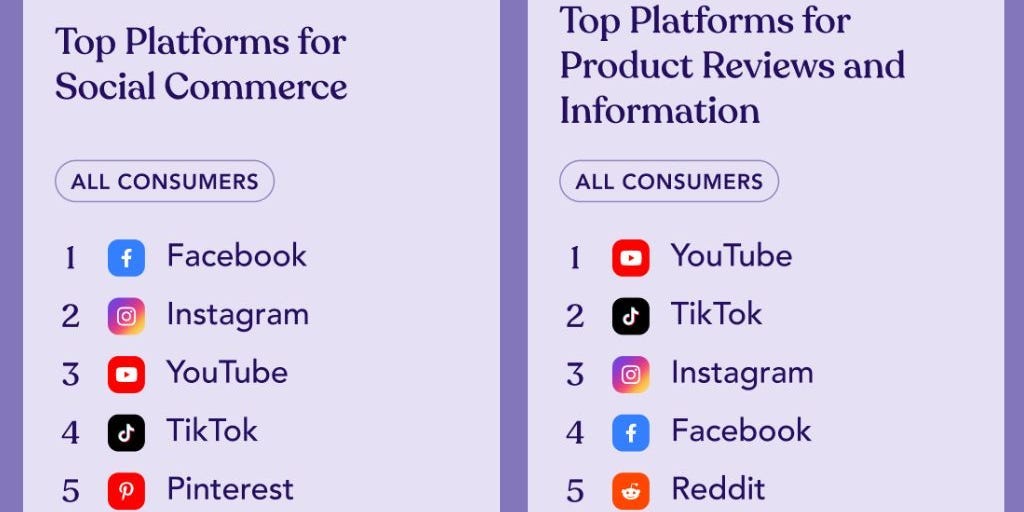Facebook is the platform where millennial and Gen-Z consumers are most likely to purchase a product, according to a new survey of US social-media users.
The influencer-marketing firm Traackr surveyed 1,000 US consumers about their habits on social media, from posting, to viewing content, to buying products. The surveyed population included millennial and Gen-Z consumers, with the aim of understanding how the space of influencer marketing is changing, Pierre-Loïc Assayag, founder and CEO at Traackr, told Insider.
Here were 5 key takeaways.
1. YouTube is the most used platform to consume creator content, followed by TikTok
Among the users who Traackr surveyed, YouTube was the most popular platform for consuming content made by creators and influencers.
“YouTube has been the slow and steady platform in the turmoil that social media has been over the years,” Assayag said. “They’re not the fastest to release new things, but they do them with a purpose and the execution tends to be well done.”
TikTok was second, followed by Instagram, Facebook, and X (formerly Twitter).
These rankings shifted when looking at age demographics, Traackr noted. For instance, among Gen-Z consumers, Snapchat displaced Facebook as a top five platform for consuming content.
However, when it came to posting content, YouTube was replaced with Instagram as the most popular platform among all consumers surveyed.
2. Short-form video is the most engaging content category across all platforms
It should come as no surprise that short-form video is the most engaging content category on social media right now, given TikTok’s rise and nearly every platform’s focus on the medium.
Traackr found that 75% of users reported that content under three minutes long was the “most engaging.”
“The fact of the matter is that short-form video offers to platforms and creators a lot more signals on what the consumer is interested in than the long-form video,” Assayag said. “If you watch a video for five minutes, I get one strong data point on what you enjoy, but if you watch 30 short-form videos and you decide to discard 20 of them after half a second, but you watch the other 10, it’s a much better signal for me as a brand manager, as a platform.”
Photos were the second most engaging content category, followed by longer-form videos over five minutes.
Here’s a breakdown of the seven most engaging content categories, according to Traackr’s survey:
-
Short-form video (< 3 minutes)
-
Photos
-
Long-form videos (> 5 minutes)
-
Livestreams
-
Text-based posts
-
Direct messages
-
Private chat groups
3. Facebook is the top platform to buy products, while YouTube is the best for product reviews
While Meta has pulled back on some social-commerce tools (such as axing live shopping and sunsetting the shop tab on Instagram), people are still frequently buying things on Meta-owned Facebook and Instagram.
TikTok and YouTube have also doubled down on their respective shopping features. Both platforms ranked behind Facebook and Instagram for social commerce, but outranked the Meta-owned competitors when it came to consumers seeking product reviews and information.
When it came to Gen-Z purchasing power, TikTok was more likely to rank number one as a platform where younger consumers were buying products.
4. Over half of consumers are more likely to purchase a product if an influencer recommends it — or even just posts about it
About 61% of consumers said that if an influencer posted about a product, they were “somewhat likely to be persuaded” to buy that product.
And if a trusted influencer recommended a product, 53% of consumers said that they were “somewhat likely” to make a purchase based on that influencer’s recommendation.
The same goes for social-media platforms that influencers recommend or use — Traackr found that 57% of consumers said they would be “somewhat likely” to try a new social-media app “if an influencer that they know and trust posts there.”
About 56% of consumers also said that they were “somewhat likely” to purchase a product from a brand that is owned by an influencer or creator they follow.
5. Consumers are still hesitant when it comes to paying for influencers’ exclusive content
To make money beyond brand deals, selling products, or ad revenue, many creators have opted for exclusive, paywalled content to generate an income.
Some turn to options like Patreon or Substack, while others have had luck cracking OnlyFans or selling online courses with platforms like Kajabi or Teachable.
However, only 41% of consumers “somewhat agree” that they would pay for exclusive content from an influencer they follow.
Read the full article here





